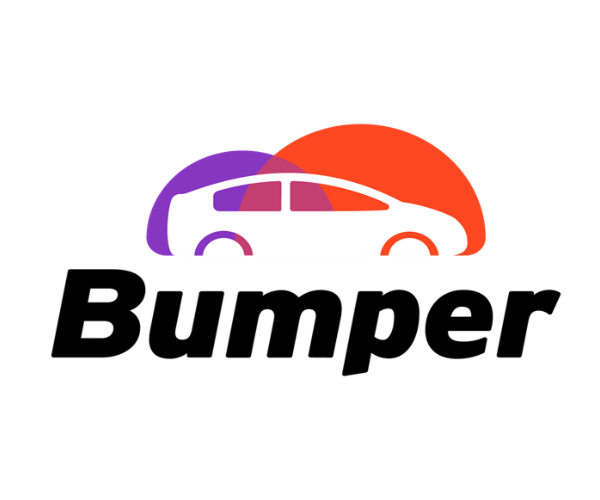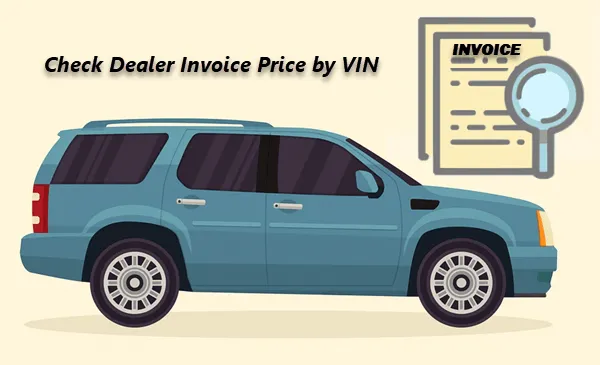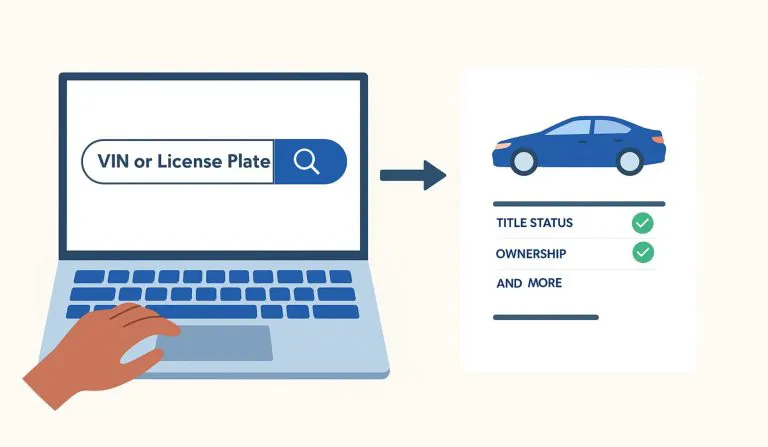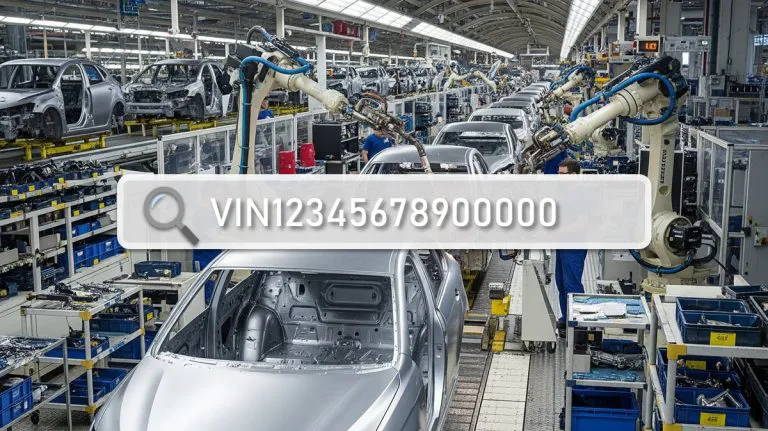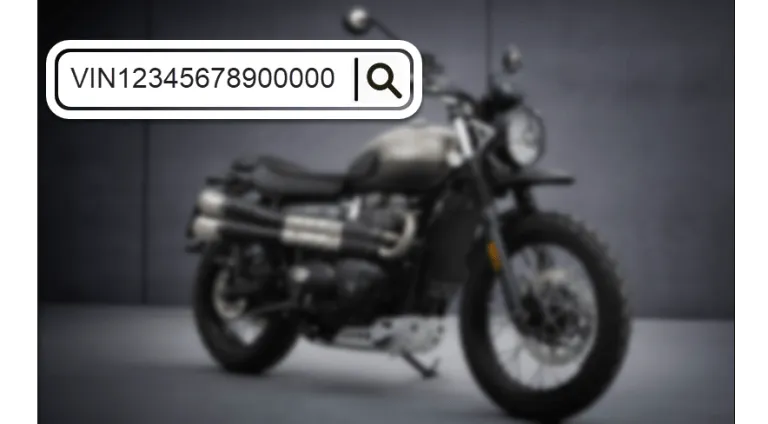Where Do VIN Lookup Services Get Their Data – And How
Understanding the most important data sources for vehicle history reports
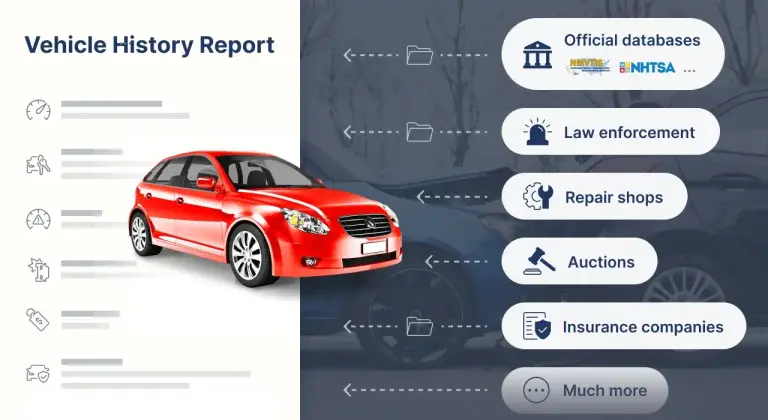
Running a VIN (Vehicle Identification Number) lookup is a classic move many people make before buying a used car, and for good reason. With just the VIN, services like Carfax, AutoCheck or Bumper can reveal a car’s past: accidents, title issues, odometer rollbacks, ownership history, and much more. But have you ever wondered where all that information actually comes from? In this article, we’ll take a closer look at the main sources behind vehicle history reports (VHR), and how VHR providers work with these partners to collect the data.
This can give you more confidence in using them, because you’ll know these reports don’t just pull information out of thin air — they’re built from real records collected from a variety of places. It also helps explain why two different reports on the same car might show different results, and why certain data might be missing from a report.
What data does a VIN report provide?
Before we dive into the data sources these services use, let’s first understand what kind of information a VIN report typically provides when you run a VIN lookup.
Through various partners, VIN reports typically aggregate the following types of data:
- Vehicle specifications
- Ownership history (number of previous owners, type of use)
- Title records
- Brand history (e.g., salvage, flood)
- Accident and damage data (including location and severity)
- Odometer reading history and potential odometer rollback
- Theft records
- Repair and service records
- Auction history and issues reported
- Inspection history and status
- Open recalls
- Liens and loans
- Warranty information
- Sale listings
- Market value
Different VIN report providers may have varying areas of focus. For example, many older players in the industry are known for providing very detailed service records, whereas some newer providers might stand out when it comes to data like market valuation.
📌 When you run a VIN check, you’ll generally obtain two categories of information. The first is the car’s specs info, such as the vehicle’s make, model, country of assembly, year of manufacture, and engine type. This data is extracted using VIN decoding logic based on global VIN guidelines, national standards and manufacturer-specific data. While this is helpful information, the main value of a VIN report lies in revealing the vehicle’s history after it left the factory. That’s why this article focuses primarily on where that type of data comes from.
Note: in this article, we use the terms “VIN check” and “VIN lookup” interchangeably. The report generated from either will be referred to as a “VIN report” or “vehicle history report (VHR)”
Table of contents
Types of data sources
VIN lookup services specialize in aggregating data throughout the entire lifecycle of a vehicle. That means their reports pull from a wide range of sources, covering many different aspects of auto ownership. These data sources generally fall into two main categories:
Ⅰ. Government and public agencies (e.g., state motor vehicle departments, law enforcement)
Ⅱ. Various partners across the auto industry (e.g., repair and service facilities, insurance companies, auto auctions)
The specific sources within these two broad categories are commonly used across many services, but it’s important to note that not every VIN lookup provider has access to all of them.
Ⅰ. Government and public agencies
Government and public agencies are among the most authoritative data sources used in vehicle history reports. They play a key role in providing official records related to vehicle titles, thefts, accidents, and more.
State motor vehicle agencies
One of the most important public sources behind vehicle history reports is the state-level government agencies responsible for vehicle registration and titling, commonly known as DMVs (Departments of Motor Vehicles). But not all states use the same name. For example, in Florida, it’s called the Florida Department of Highway Safety and Motor Vehicles (HSMV), and in Washington, it’s the Washington State Department of Licensing (DOL).
Here’s what state DMVs (or their equivalents) typically provide:
- Branded titles, including salvage/junk, flood, and more[1]
- Registration records, including city and state of previous registration
- Number of owners
- Accidents and damage reports, stolen vehicles
- Original vehicle use (e.g., rental, taxi, lease)
- Lien information and ownership transfers
- Manufacturer buybacks or lemon titles[2]
- Odometer readings (typically collected at the time of registration or title transfer)
National Motor Vehicle Title Information System (NMVTIS)
National Motor Vehicle Title Information System (NMVTIS) is an electronic federal database managed by the Department of Justice. It collects data from state motor vehicle titling agencies, insurance carriers, auto recyclers, junk yards, and salvage yards[3], all of which are required by federal law to report on a regular basis.
The system’s primary function is to serve as a reliable source of title and brand history for a vehicle. Specifically, NMVTIS provides information such as:
- Title brands, including the brand type, branding date, and the state that issued the brand
- Title records, including the title issue date and odometer reading at the time of issuance
- Junk and salvage records
- Insurance total-loss records (if reported to NMVTIS)

This database offers remarkably broad coverage. Currently, 99% of the U.S. DMV data is represented in the system based on the most current Federal Highway Administration Data[4].
📌 Can I search the NMVTIS database directly?
Generally, the general public cannot access the NMVTIS database directly. Unlike other types of public records (such as property records), there’s no official government website where you can simply run a search yourself. Instead, consumers must go through an approved NMVTIS data provider to request title-related information.
📌 Can all VIN lookup services access NMVTIS data?
Note that not every VIN lookup service is an approved NMVTIS data provider. If a service is approved, that means it has direct access to this official database and is often granted more consistent and standardized access to official title-related data across states.
Many services, however, are not NMVTIS approved data providers. Take Carfax, for example. It can’t pull title data directly from NMVTIS for the reports it offers to consumers[5]. Instead, they rely on alternative sources, such as individual state DMVs or a wide range of corporate partners to gather similar information.
National Insurance Crime Bureau (NICB)
The NICB is a nonprofit organization backed by the insurance industry. It plays a critical role in preventing and investigating vehicle theft and insurance fraud. On its website, the NICB offers a free lookup tool that allows the public to check whether a specific VIN has a record of an insurance theft claim (and not yet recovered), or reported as a salvage vehicle[6] by participating NICB member insurance companies. It’s worth noting that this tool is available to the public, but there is a limit of five searches per IP address within a 24-hour period.
Although the NICB is not a government agency, it is considered a highly authoritative source within the industry. Its data is commonly listed among the sources used by many major VHR providers.
National Crime Information Center (NCIC)
In addition to the NICB, another important contributor of vehicle theft data is the FBI’s National Crime Information Center (NCIC). The NCIC is a federal system that aggregates theft data from around 18,000 criminal justice and law enforcement agencies across the U.S. Similar to NMVTIS that we mentioned earlier, it functions as a centralized federal database. Notably, NCIC’s national data also includes reports of stolen vehicles that are self-insured or uninsured — cases that may not be reflected in other databases.
National Highway Traffic Safety Administration (NHTSA)
The NHTSA is a federal agency under the U.S. Department of Transportation, responsible for overseeing vehicle safety and regulations. When it comes to vehicle history, the NHTSA is the go-to source for safety recall information. Like the NICB, it offers a free lookup service on its website. By entering the VIN (or license plate number + state), anyone can check if a specific vehicle has any unrepaired safety recalls.
Since the NHTSA provides free API access, VIN lookup services often build automated systems that query NHTSA APIs in real time or at regular intervals. Whenever a user searches for a VIN, the service can retrieve the latest recall status and safety info directly from the NHTSA’s official source.
Law Enforcement agencies & fire departments
State and local law enforcement agencies are important sources of stolen vehicle and theft recovery records. Police departments across different jurisdictions also provide accident reports that may be included in VIN check services. In addition, fire departments can contribute fire damage reports from across the U.S.
Ⅱ. Various partners across the auto industry
Now that we’ve covered key public and government sources, let’s turn to another major category: industry partners. These are organizations involved in various stages of a vehicle’s life — insurance companies, repair shops, dealerships, auto auctions, and so on. While they’re not public agencies, they often generate valuable data through their routine business operations. VIN lookup services rely heavily on this kind of industry-sourced information to fill in gaps, verify details, and create a more complete picture of a vehicle’s history.
Insurance companies
Some people believe that any insurance claim will automatically appear on a VIN report. In reality, insurers don’t automatically participate in the data-sharing ecosystem. Instead, VHR providers must negotiate and form agreements with insurance companies to purchase vehicle history data. Whether or not an insurer chooses to share this information depends on state laws as well as its own internal policies and considerations. Some agree to partner with these services, while others opt not to.
VHR providers place a high value on insurance company data — and for good reason. Auto insurance coverage is widespread, and in the event of an accident, damage, or theft, insurance companies are often among the first to be notified (aside from law enforcement). As a result, the data they collect serves as a crucial supplement to government records, helping fill in gaps that might otherwise go unreported.
For example, insurance companies are a key source of total loss data. We all know that a salvage/junk title issued by a state DMV is one of the clearest red flags when evaluating a used car. But the reality is, a car that has been written off doesn’t always end up with one of these branded titles[7]. However, if an insurance company decides the vehicle was a total loss or it was reported stolen, that information might still be shared with VIN lookup services, even if the official title looks clean.
Even if the damage to a vehicle isn’t that severe, a damage record can still be passed along to VHRs. To give you a general idea: typically, when a vehicle is damaged, the owner reports the incident to their insurance company. The insurer then processes the claim and often directs the owner to an authorized repair shop. Once the repair and claim process is completed, a record is generated. If the insurance company has a data-sharing agreement with a VIN check service, this record is then reported to them.
Now you might be wondering: if the owner didn’t file an insurance claim, does that mean VIN lookup services won’t know about the damage to this car? Not necessarily. If they took their vehicle to a body shop or repair facility, there’s still a chance the repair data was reported and made its way into a vehicle history report. Just read on…
Repair and service facilities
Another category of data-sharing partners within the auto industry that VIN lookup services rely on comes from facilities such as repair shops, body shops, and service or maintenance centers. Similar to insurers, Carfax and other vehicle history providers form data-sharing agreements with those businesses that are willing to share their data.
This type of data is especially valuable because not all damage or mechanical issues are reported to insurance companies or reflected in official government records. For example, if a vehicle owner pays out of pocket to repair collision damage or replace major components, those events might never appear in DMV or insurance databases. However, if the repair shop they visited shares data with VHR providers, the repairs could still become part of the vehicle’s history report.
📌A seamless data flow
VHR providers often establish convenient and mutually beneficial programs to facilitate data sharing with these partners. One of the most effective ways involves one-stop shop management software (SMS) widely used by repair shopsto streamline operations. Some of these software platforms are already integrated with VIN report providers. As a result, VIN check services can receive a wealth of information directly from the shop’s service records via the SMS provider, including VIN, date, mileage, and repair order details.
For example, over a decade ago, Carfax launched its Service Link program. Dealerships, repair shops, and even rental companies could voluntarily join the program for free. Once joined, they allowed automatic uploads of relevant data to Carfax on the selected day of the week. In return, these businesses could benefit from free advertising through links to their website on the Carfax reports.
However, since data sharing is based on partnerships, if you take your car to an independent mechanic in a small town that doesn’t report to VIN check services, those repairs may never appear on a VHR.
A VHR with limited service records doesn’t necessarily mean the vehicle was poorly maintained. Some owners are hands-on and perform routine maintenance, such as oil changes, themselves. In this case, there may be no official service entries in the report[8].
Auto auctions and salvage auctions
VIN check services are able to gather valuable info from auto auctions because vehicles sold at auction are subject to specific disclosure rules. Auctions typically include an “announcement” section where any known issues with the vehicle must be declared. For example, one well-known auction requires sellers to disclose if more than two panels have been refinished, let alone more serious concerns like structural or frame damage. These announcements help VIN check services capture detailed insights that might not be available through other sources. Other severe issues, such as flood damage and salvage-title history, are also reported when known.
Aside from revealing damage, auction announcements can provide many additional details about a vehicle’s history, such as odometer readings and original vehicle use.
To give you an idea, take AutoCheck as an example. In its reports, you might come across auction announcements like the following[9]:
- Auction Announced as Structural/frame/unibody Damage
- Auction Announced as Fleet/Lease
- Auction Announced as Flood Damage
- Auction Announced as Manufacturer Buyback/Lemon
- Auction Announced as Odometer Rollback
- Auction Announced as Repossessed
Dealerships
Dealerships are clearly important contributors when it comes to vehicle acquisition and sale events, for example, when a car was listed or sold by a dealership. This helps track the vehicle’s movement through the market and ownership changes.
Also, dealerships often record odometer readings during routine services, inspections, trade-ins, or sales, which can help flag potential mileage rollbacks.
Many dealerships also operate in-house service centers, allowing them to provide VIN history providers with detailed service and maintenance records.
Rental and fleet companies
You might be surprised to learn that a large proportion of 1–2-year-old used cars were previously rental vehicles. While these cars may not be as desirable as cars of personal use, they’re not always a bad buy. What really matters is how well they’ve been maintained. That’s why VIN report providers partner with rental and fleet companies to access fleet vehicle maintenance records, which can give buyers insight into how well the vehicle was cared for[10]. Additionally, if a fleet vehicle was ever involved in a total loss or sustained damage, that information can be included in the report as well.
Automotive recyclers
As mentioned earlier, many automotive recyclers (also known as salvage yards or junk yards) are required to report to NMVTIS. However, if a recycler doesn’t participate in NMVTIS, or if a VIN lookup service doesn’t have access to NMVTIS data, the service can still obtain this information through direct data-sharing partnerships with individual recyclers. They can help VIN lookup services flag a vehicle as previously damaged or totaled, even if it doesn’t carry a branded title yet. They may also uncover damage events that were never reported to law enforcement or insurance companies.
Import/export companies
Import/export companies handle the cross-border transportation of vehicles. During this process, they generate records related to a car’s shipping history, export status, and destination country. Data from these partners can help identify a vehicle’s out-of-country history and verify its compliance with emissions standards.
Inspection sites
Emission tests (also known as Smog Checks) are usually a requirement for vehicle registration renewal. If a vehicle fails the emission test, the owner needs to complete repairs before being able to re-register it. Therefore, VIN report providers partner with inspection sites and state inspection stations to verify whether the vehicle passed its emissions and safety testing.
Manufacturers (OEMs)
Manufacturers can provide the following information:
- Open recalls (Identify recalls that need to be completed)
- Certified pre-owned (CPO)[11] vehicles (Identify vehicles inspected and certified by manufacturers)
- Service and maintenance history
- Buybacks (Indicate if a vehicle was repurchased by the manufacturer, often due to lemon law claims.)
- Warranty information
- Vehicle specifications
Other data sources
The data sources mentioned above are the most common ones used by VIN check services (though the actual list of contributors can vary from one provider to another). To gain a competitive edge in the market, many providers go beyond these standard sources and form partnerships with unique or less conventional sources. Below are a few typical examples of such efforts:
J.D. Power
J.D. Power is an American data analytics and market research company that is particularly renowned in the automotive industry. It serves as a key source of vehicle market value data for services like Bumper. Accurate and unbiased J.D. Power values are built on a 90-year legacy. Over 20 million vehicle transactions per year are analyzed with rigorous methodology and leading data science. In addition to a retail value, they provide trade-in values for rough, average and clean vehicles.
Bumper sample report – market value section
National Vehicle Service (NVS)
The NVS is widely recognized as the nation’s leader in providing unique vehicle theft, vehicle fraud and asset protection solutions to the law enforcement community, vehicle finance, insurance, and rental car industries. It provides lien history data, open recalls, export records and vehicle impoundment to services like VINsmart and clearVIN.
Publicly available information on the Internet
In addition to formal partnerships and official data sources, VIN check services might also leverage data crawling (or web scraping) to gather useful information about a vehicle. For example, many auto auction data are publicly accessible, with the vehicle’s details listed, including the VIN, specs, auction dates, mileage at the time of listing, title and condition, and even photos from different angles. Similarly, sale listings on used car marketplaces (whether on sites like Craigslist or various dealership websites) often contain valuable details that can be scraped and integrated into a vehicle history report.
Making sense of overlapping data sources
As you’ve probably noticed by now, the same type of information can come from different sources. For example, accident records might be reported by law enforcement, insurance carriers, or body shops. Similarly, odometer readings data can come from the state DMV, auto auctions, or dealerships.
Rather than a flaw, this overlapping can actually help VIN lookup services ensure better accuracy and completeness:
- When multiple sources confirm the same data, it tends to be more reliable.
- If one source doesn’t report something, another might catch it. If an insurance company fails to report a minor accident, the repair shop that fixed the damage might. Having more than one source means important events are less likely to be missed.
- Contradictory data can help spot red flags. If mileage numbers suddenly drop or fluctuate between sources, it could mean an odometer rollback[12].
Why learning about data sources matters: unpuzzling your big questions about VIN reports
Now that you understand how Carfax and similar services gather the data that makes up a vehicle history report, you probably have a clearer picture of some questions that may have puzzled you before.
1. Can I find vehicle history data without a VIN report?
You might be wondering: If I’m willing to spend some extra time doing my own research online or in person, do I really need to pay for a vehicle history report?
Well, it’s true that you can find some of the information included in a VHR by searching manually. For example, as mentioned earlier, some official sources offer free lookup tools to the public, like the NICB’s tool for checking theft history or NHTSA’s recall lookup.
Unfortunately, though, most of the valuable information isn’t so easily accessible. The NMVTIS database, one of the most important official sources, doesn’t offer a search portal. And as for industry partners, their data isn’t typically shared with the public. They only provide it through agreements with VHR providers.
And even if you can find a piece of the puzzle, it rarely tells the whole story on its own. To get a full picture of a car’s history, you usually need complementary information from other sources. VIN check services specialize in aggregating a massive amount of data from many different places and compile it into an easy-to-read report, saving you a lot of time and effort.
2. Why do reports on the same vehicle show different details?
As we’ve explained in this article, not all VIN check services have access to the same databases or systems. Some may be approved to pull data from a specific official source, while others are not.
And when it comes to industry partners, such as insurance companies, repair shops, or auctions, access depends entirely on individual agreements. Consequently, different reports might have some overlapping data, but they could also each cover unique pieces of information that the others don’t.
For example, some forum users shared that after an accident, they didn’t report it to the police, but filed an insurance claim. Suppose VHR Provider A is an NMVTIS-approved data provider, and the user’s insurer reports to NMVTIS, then the record would appear in Report A. But if Provider B isn’t NMVTIS-approved and that insurer happens to be outside of their contributor network, the accident won’t appear in Report B.
In addition, the update frequency of the data sources themselves can impact the accuracy and completeness of different reports. For instance, some databases update their vehicle damage data every 24 hours, while others do so only once a week. In that case, a VIN lookup service relying on the latter as its data source might temporarily be missing damage information that occurred just a few days ago.
3. Are vehicle history reports 100% complete or accurate?
You may have seen users complain about the quality of reports provided by Carfax or similar services, such as known records not showing up as expected. But does this mean these reports are just a waste of time? Can we trust them at all?
To answer the question, here’s a key point to keep in mind: no matter which VIN lookup service you’re using, it’s only as good as the information it receives. In other words, their reports can only show what has been reported to them — something most of them clearly state in their disclaimers.
Each service works hard to build its own network of data contributors, but not every business agrees to share data[13]. If an independent repair shop, for example, refuses to feed data to Carfax or any other VIN lookup services, then any work done there simply won’t show up on the report. And all sorts of DIY work may fall through the cracks as well.
🔘 Example: how certain records can completely escape a report
Let’s consider a somewhat extreme example. Imagine a car gets into an accident, but the owner doesn’t report it to the police. He didn’t file a claim with their insurance company either to avoid any raise in their premiums. Instead, they take the car to an independent local collision repair shop which isn’t part of any major chain and pay out of pocket. This owner is also very car-savvy, fixing minor issues themselves and changing the oil every 5,000 miles at home.
In this scenario, if you check a Carfax or Bumper history report for this car, there will be a complete absence of accident/damage data and very few service records. But it would be unfair to conclude from this that these services are worthless.
It’s also important to understand that state laws vary. Some states have stricter regulations around data sharing, and detailed claim information held by the state’s Department of Insurance or by insurers may not be legally allowed to be shared with third parties. This can also explain why certain details may be missing from a VIN report.
Additionally, it takes time for vehicle history data to appear on a report. Not all data sources update in real time. Some may take a week or even longer to transmit the latest information. And once the data is received, providers still need time to process it before it shows up in the report.
For example, the image above shows a vehicle’s inspection history retrieved from the California Bureau of Automotive Repair. The car passed a state emissions inspection just two weeks before the search date. However, the VIN report only reflects the previous inspection.
A vehicle history report is NOT a substitute for an independent vehicle inspection
As we’ve seen, VHRs can help you quickly eliminate many of the worst cars and save money and time. While they aim to be as comprehensive as possible, they’re not perfect. That’s why we strongly recommend that you use it alongside a test drive, an independent pre-purchase inspection (PPI) by a trusted shop/mechanic as well as an open conversation with the seller. In short, use the vehicle history report as your research tool, not your final decision-maker.
Footnotes
- Keep in mind that branding rules vary by state. For example, the total loss threshold for assigning a “salvage” title differs across states. Also, some states apply specific brands like “flood,” while others may not.↩
- A “lemon car” refers to a vehicle that has significant defects that impair its use, value, or safety. These defects are often persistent, meaning they cannot be repaired successfully after multiple attempts. If a car qualifies as a “lemon” under lemon laws, it can trigger a manufacturer buyback or other remedies.↩
- Auto recyclers and junk and salvage yards that handle fewer than five vehicles per year that are determined to be salvage (including total loss) or junk are not required to report to NMVTIS consistent with federal legal requirements for automobile dealers.↩
- Bureau of Justice Assistance. (n.d.). For states. National Motor Vehicle Title Information System. https://vehiclehistory.bja.ojp.gov/nmvtis_states#0-0↩
- According to NMVTIS, consumers cannot receive NMVTIS Vehicle History Reports from Carfax, DMVDesk, or Experian; these entities provide information only to car dealerships.↩
- In addition to cases where a vehicle is severely damaged and the repair costs are too high, a salvage title can also be issued due to theft.↩
- This can happen for several reasons, such as the damage not meeting the threshold required for a branded title in that state.↩
- If you’re buying from a private seller, it’s a good idea to ask the current owner to help fill in those gaps in the vehicle’s maintenance or repair history.↩
- AutoCheck. (n.d.). AutoCheck Glossary. AutoCheck. https://www.autocheck.com/vehiclehistory/glossary↩
- Example of such a partnership: Autorentalnews. (2008, March 1). Carfax now available to rental fleets. https://www.autorentalnews.com/146518/carfax-now-available-to-rental-fleets↩
- A certified pre-owned (CPO) car is a used vehicle that has been thoroughly inspected and repaired (dealer-certified or manufacturer-certified) as needed, and may be covered by the manufacturer’s or dealer’s warranty.↩
- Or it could be just a data entry error. Yes, that happens.↩
- Example of businesses not willing to share data: Robison, J. (2011, October 17). We won’t be feeding data to CARFAX. Here’s why… JE Robison Service. https://robisonservice.blogspot.com/2011/10/we-wont-be-feeding-data-to-carfax-heres.html↩
 View all of Jocelyn Sun's posts.
View all of Jocelyn Sun's posts.